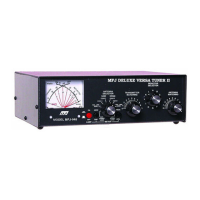
Do you have a question about the MFJ Enterprises MFJ-948 and is the answer not in the manual?
| Type | Antenna Tuner |
|---|---|
| Frequency Range | 1.8-30 MHz |
| Impedance | 50 Ohms |
| Tuning Method | Manual |
| Antenna Switch | Yes |
| Power Rating | 300 W PEP |
| Meter | Built-in SWR/Wattmeter |
| Power Handling | 300 W PEP, 150 W continuous |
Describes the cross-needle meter for forward/reflected power and SWR measurements.
Warns about high RF voltages on rear terminals and the risk of burns or damage.
Provides instructions for connecting the transmitter, coaxial feedlines, and wire antennas.
Explains the function of the "T" network, capacitance, and inductance controls.
Covers tuning the transmitter output and using the bypass function.
Presents the tuning chart and initial steps for setting controls by frequency.
Details how to adjust TRANSMITTER and ANTENNA MATCHING for lowest SWR.
Guidance on increasing transmitter power once low SWR is achieved.
Advice for troubleshooting tuner arcing at rated power levels.
General advice for when the tuner fails to tune or operates improperly.
Explains the importance and methods for effective RF and lightning grounding.
Recommendations for antenna location and specific configurations for optimal performance.
Emphasizes connecting a good earth ground for operator safety.
Explains how feedline and antenna lengths can cause matching difficulties.
Offers suggestions to reduce complexity when matching antennas.
